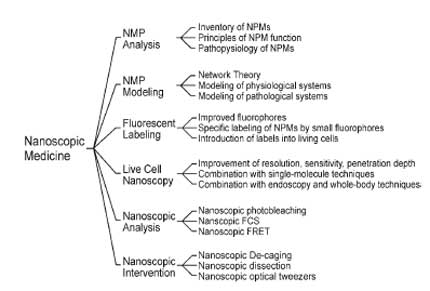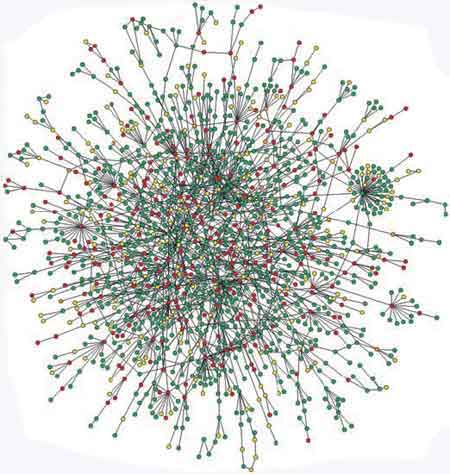| Posted: Mar 09, 2006 | ||
Nanoscopic medicine: the emergence of a new medical specialty |
||
| (Nanowerk News) A novel discipline is emerging in medicine: nanoscopic medicine. Based on the premises that diseases manifest themselves as defects of cellular proteins, these proteins have been recently shown to form specific complexes exerting their functions as if they were nanoscopic machines. Nanoscopic medicine refers to the direct visualization, analysis (diagnosis) and modification (therapy) of nanoscopic protein machines in life cells and tissues with the aim to improve human health. | ||
| The term nanoscopic medicine was coined by a group of researchers in Germany whose mission is to extend live cell nanoscopy into a comprehensive diagnostic and therapeutic scheme. This includes both the creation of a set of novel instruments and the analysis of nanoscopic protein machine networks in health and disease. In addition, they seek to construct artificial devices mimicking cellular nanomachines. | ||
| Professor Reiner Peters and his team at the University of Münster (they also formed a separate spin-off company called Nascomed) in Germany told Nanowerk: "We are striving to a rapidly develop medical nanoscopy. However, the future implementation into medical praxis will depend on whether we succed in unifying all the parts of this new field, which are currently dissipated among disciplines such as genomics, proteomics, structural biology, systems biology, physical optics, photochemistry and medicine." | ||
| In two recent papers, the researchers introduce their concept. "Checking and fixing the cellular nanomachinery: towards medical nanoscopy" was published in the Feb. 2006 edition of Trends in Molecular Medicine and "Nanoscopic Medicine: The Next Frontier" was published in the March 1, 2006 online edition of small. | ||
| While nanoscopy refers to the visualization of structures on the nanometer scale, "medical nanoscopy" goes beyond diagnostics by including therapeutic applications as well. | ||
| "The target of nanoscopic medicine is that of traditional medicine, the diagnosis and therapy of the cell. However, the frontier is moved deep inside the cell towards its nanoscopic fundament" says Peters. | ||
| He explains an important distinction to nanotechnology: "Nanoscopic medicine must be clearly distinguished from applications of nanotechnology to medical questions, frequently referred to as nanomedicine. Nanoscopic medicine and nanomedicine represent opposing approaches. The roots of nanoscopic medicine lie in medicine while those of nanomedicine are found in nanotechnology." | ||
| He adds "Nanoscopic medicine seeks to analyze and improve the nanoscopic fundament of the cell while nanomedicine aims at the creation of artificial nanometer-sized devices such as particles, tubes, or sieves, if not electromechanical robots, for diagnostic and therapeutic purposes." | ||
 |
Taxonomy of nanoscopic medicine. (Reprinted with permission from Wiley-VCH Verlag GmbH & Co KG) | |
| Nanoscopic Protein Machines (NPM) | ||
| Some protein complexes work as if they were nanometer-sized machines. NPM have clearly discernable parts, which move relative to each other during action, execute complex reactions in a specific order and frequently consume energy. | ||
| In living cells, protein complexes cooperate with each other to form functional modules – relatively autonomous ‘assembly lines’ arising from self assembly or positional assembly. | ||
| The emergence of the cell as a collection of protein machines has prompted attempts to create mathematical models able to mimic and predict cellular behavior. However, with a complex system such as the human cell, which involves ∼50,000-60 000 different proteins and an estimated 200,000 interactions, such an approach might be impractical. Instead, graph theory is used to construct networks in which the components are represented as nodes and their interactions as connections between nodes. However, the large number of parameters in such networks poses a mathematical challenge and current efforts are concentrating on simplifications. | ||
 |
Nanoscopic protein machines form extended networks. Protein?protein interactions in yeast, measured by the two-hybrid technique, are displayed by a diagram in which nodes and lines represent proteins and their interactions, respectively. The diagram reveals that interactions are extensive and follow a hierarchical, nonrandom pattern. (Reprinted with permission from Wiley-VCH Verlag GmbH & Co KG. Original copyright Macmillan Magazines Ltd.) | |
| Live Cell Imaging | ||
| The nanoscopic range first became accessible for fluorescence microscopy by single-molecule techniques (SFM - single-molecule fluorescence microscopy). Although single molecules are not resolved by these techniques, in living cells, localization accuracies of 20?30 nm have been obtained at a time resolution of a few milliseconds. A unprecedented increase in resolution, eventually breaking classical limits, was recently achieved by 4Pi microscopy and stimulated emission depletion (STED) microscopy. | ||
| In 4Pi microscopy, an object is positioned between two opposing objectives; the object is illuminated through these objectives by laser beams focused down to the diffraction limit. Fluorescence emitted from the focal spot is collected by both objectives and directed onto a sensitive photodetector. Images are obtained by scanning the object relative to the beam and by reconstructing an image from the point measurements. So far, a resolution of 30 nm has been obtained by combining STED with 4Pi microscopy. | ||
| Modification (Therapy) of NPM | ||
| Nanoscopic medicine is an emerging discipline that needs massive development before it can be incorporated into medical practice. Most of the fields involved are in an early state. A number of techniques for the quantitative analysis of molecular processes in microscopic systems have already been established. However, techniques such as fluorescence microphotolysis (fluorescence photobleaching), fluorescence correlation spectroscopy, and fluorescence resonance energy microscopy have yet to be adapted to the nanometer scale. Similarly, techniques for the photochemical and photomechanical manipulation of microscopic systems are available, but have yet to be adapted to the nanoscale. | ||
 By
Michael
Berger
– Michael is author of three books by the Royal Society of Chemistry:
Nano-Society: Pushing the Boundaries of Technology,
Nanotechnology: The Future is Tiny, and
Nanoengineering: The Skills and Tools Making Technology Invisible
Copyright ©
Nanowerk LLC
By
Michael
Berger
– Michael is author of three books by the Royal Society of Chemistry:
Nano-Society: Pushing the Boundaries of Technology,
Nanotechnology: The Future is Tiny, and
Nanoengineering: The Skills and Tools Making Technology Invisible
Copyright ©
Nanowerk LLC
|
||
Become a Spotlight guest author! Join our large and growing group of guest contributors. Have you just published a scientific paper or have other exciting developments to share with the nanotechnology community? Here is how to publish on nanowerk.com.
